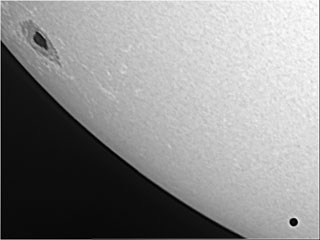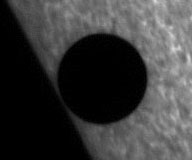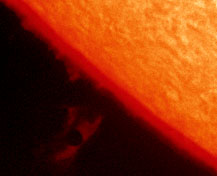
Don Parker of Coral Gables, Florida, photographed Mercury near the Sun's largest sunspot shortly after the transit began. He stacked 240 images shot through his 16-inch Newtonian stopped down to 6 inches.
Don Parker
Sunspots are rare at solar minimum, and November 8, 2006, was no exception. But the three sunspots that were present were strategically placed to mark Mercury's passage in front of the Sun. The innermost planet began its transit across the Sun's disk directly south of the largest spot, and for a while it appeared to be headed directly toward the other two, which formed a pair near the opposite limb. But as the five-hour event unfolded, it became clear that Mercury would pass south of those spots as well.
Conditions were best in Southern California, where observers wittnessed the transit from start to finish with the Sun reasonably high in the sky. Conditions in the rest of North America were more problematic. Except for Florida, the East Coast was blanketed by clouds, and the weather was in flux in many other places, forcing people to glimpse the event through gaps in the clouds.

The Hinode satellite captured 2nd contact in extraordinary detail.
Hinode
Calgary, Alberta, was an extreme example, as frequent Sky & Telescope contributor Alan Dyer explained: "We saw the first two hours of the transit from noon on, then the clouds thickened, and by 5 p.m. it was a blizzard, and the highways were being closed!"
Clouds weren't a problem for solar observatories in orbit, including TRACE (Transition Region and Coronal Explorer), SOHO (Solar and Heliospheric Observatory), and Hinode (formerly Solar-B). But some ground-based observers made photographs that were nearly as sharp, like Don Parker's photograph above, a stack of 240 images shot through his 16-inch Newtonian stopped down to 6 inches. Parker's conditions in Coral Gables, Florida, were far from ideal, including lots of clouds and high winds — complaints that were echoed by many other successful observers as far away as Hawaii and Australia.

Mercury in front of a solar prominence.
Fred Bruenjes
Fred Bruenjues of Ramona, California, even managed to catch Mercury before it made contact with the Sun, while crossing a small solar prominence. He describes his image as "heavily processed." A movie of the same event was recorded by the National Solar Observatory.
The next transit of Mercury will happen on May 9, 2016. But before that, there will be a far more spectacular transit of Venus on June 6, 2012. Venus is three times Mercury's size, and its only half as far from Earth when it passes between us and the Sun, so it appears six times bigger across, or 36 times bigger in area. Both of the forthcoming transits will be visible from North America.
 0
0
Comments
You must be logged in to post a comment.